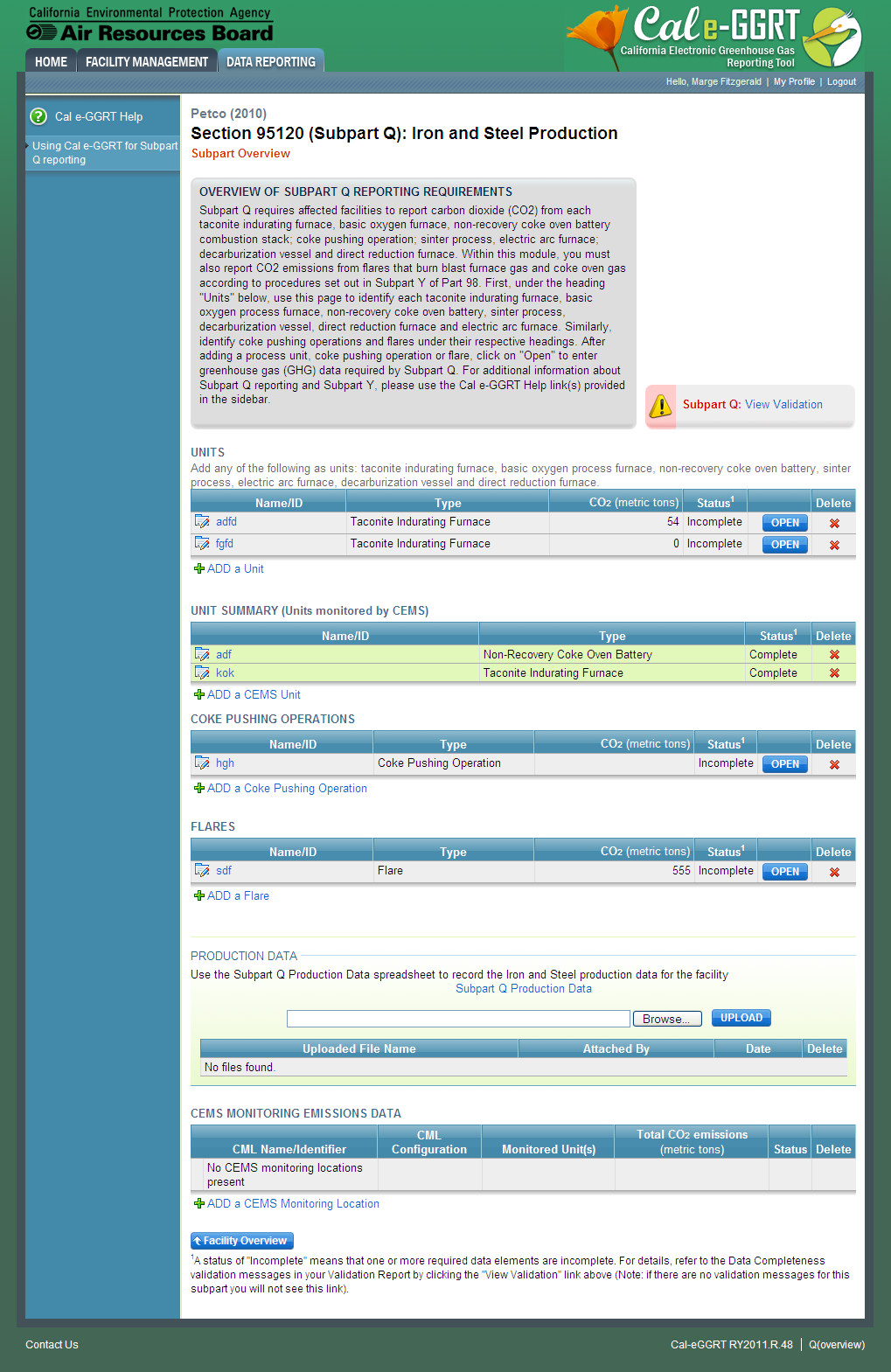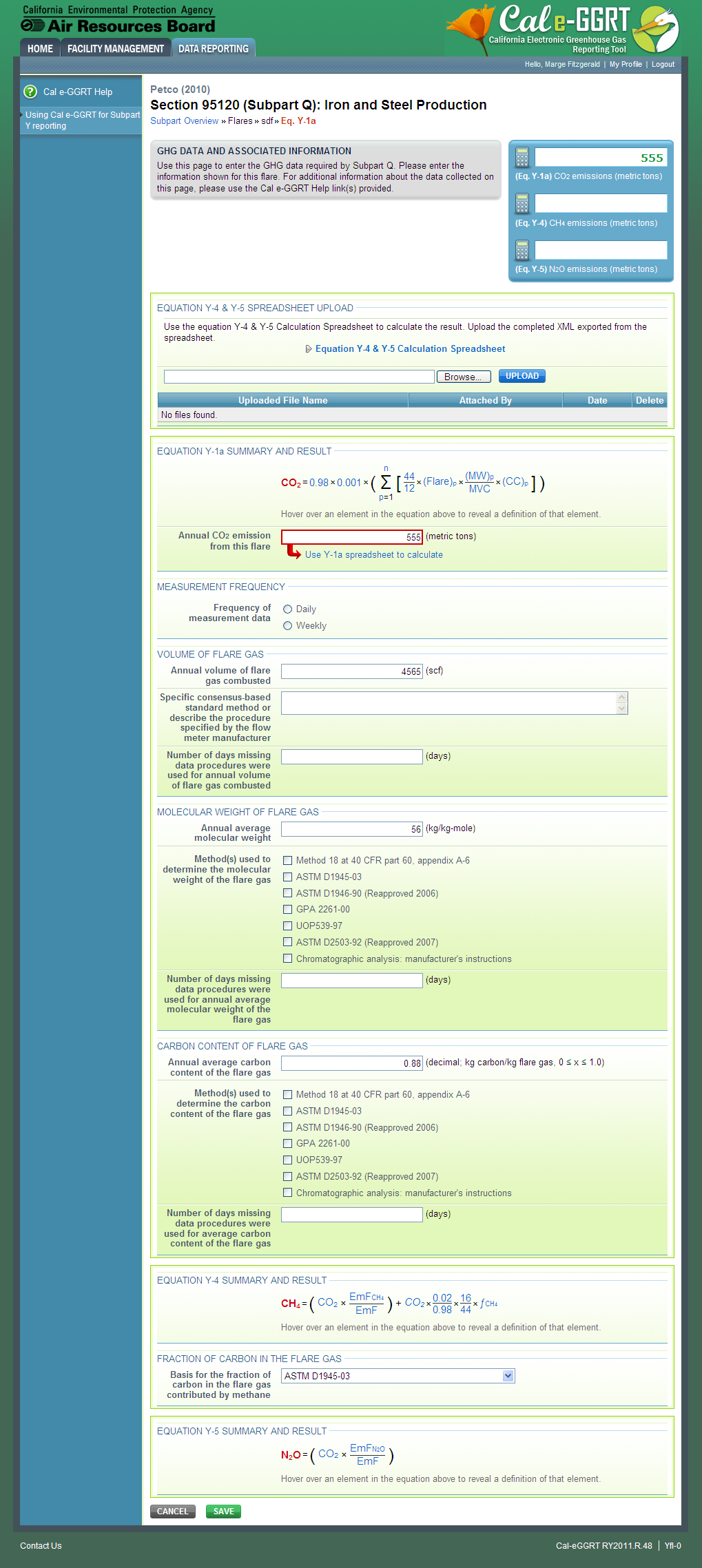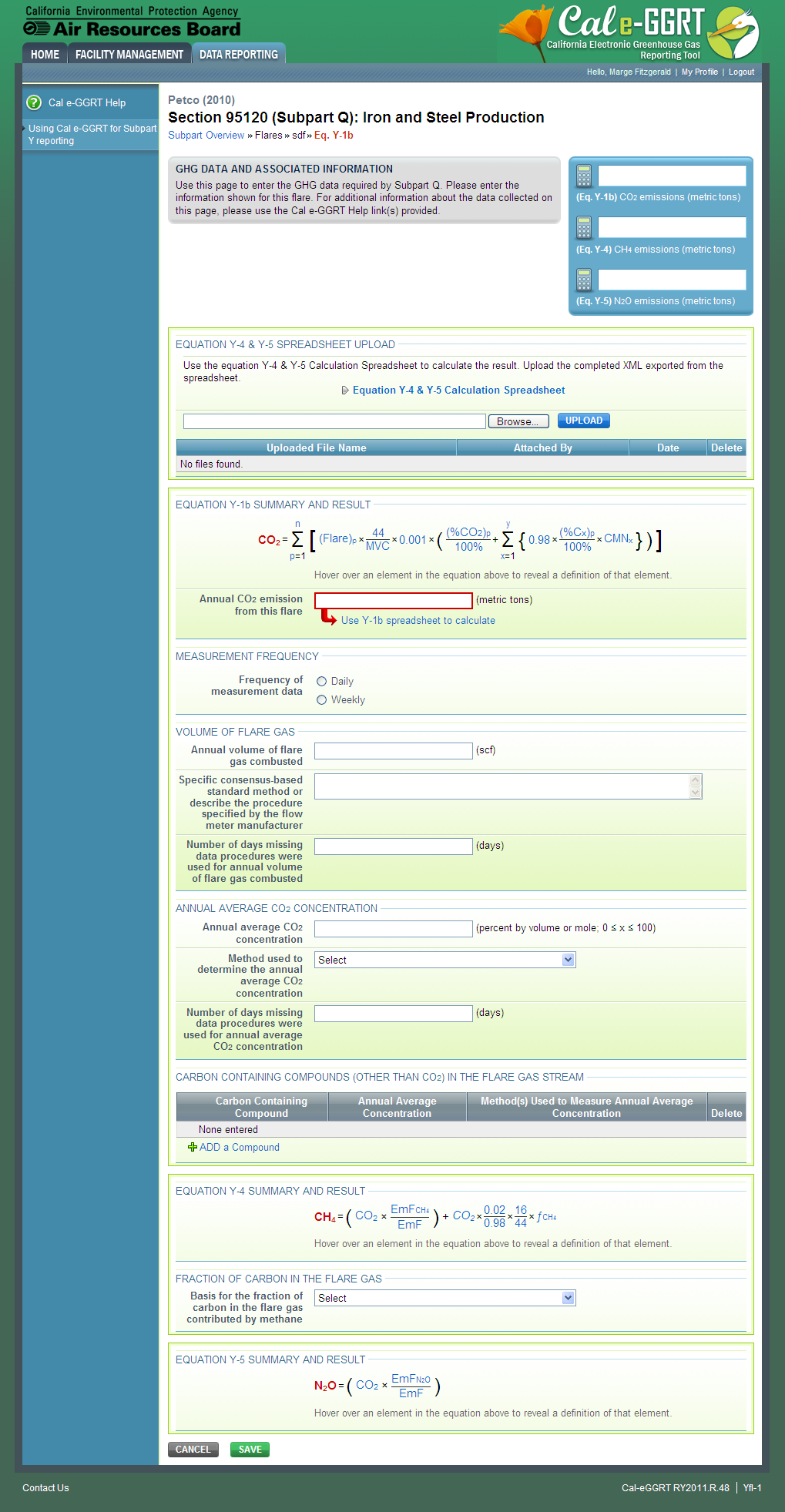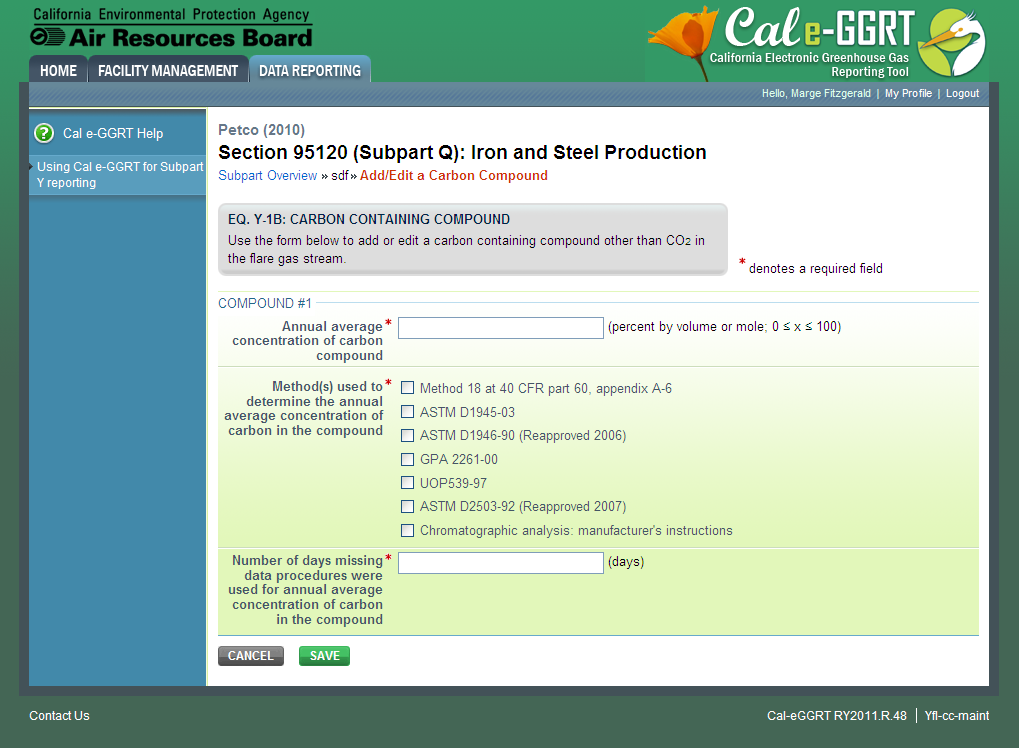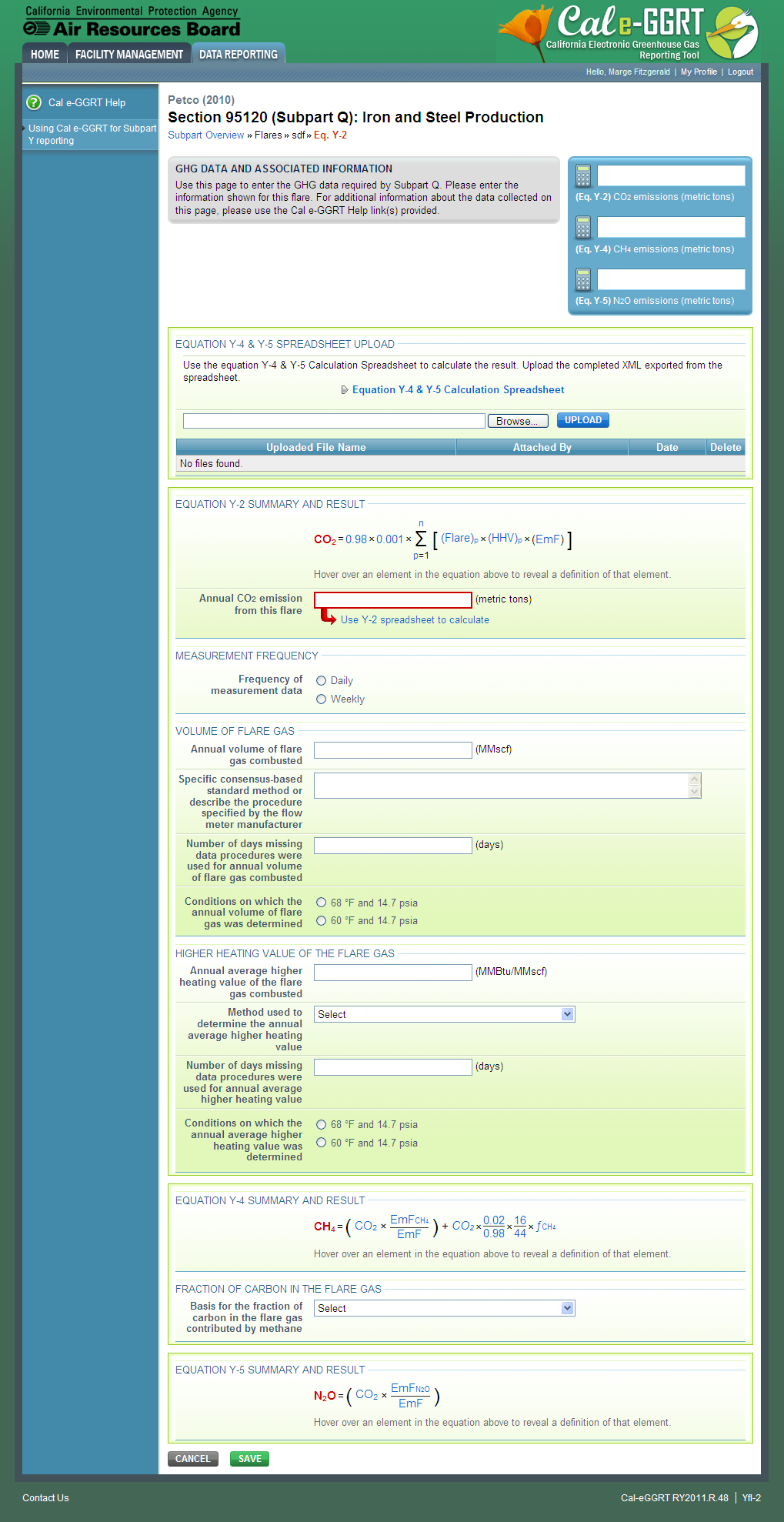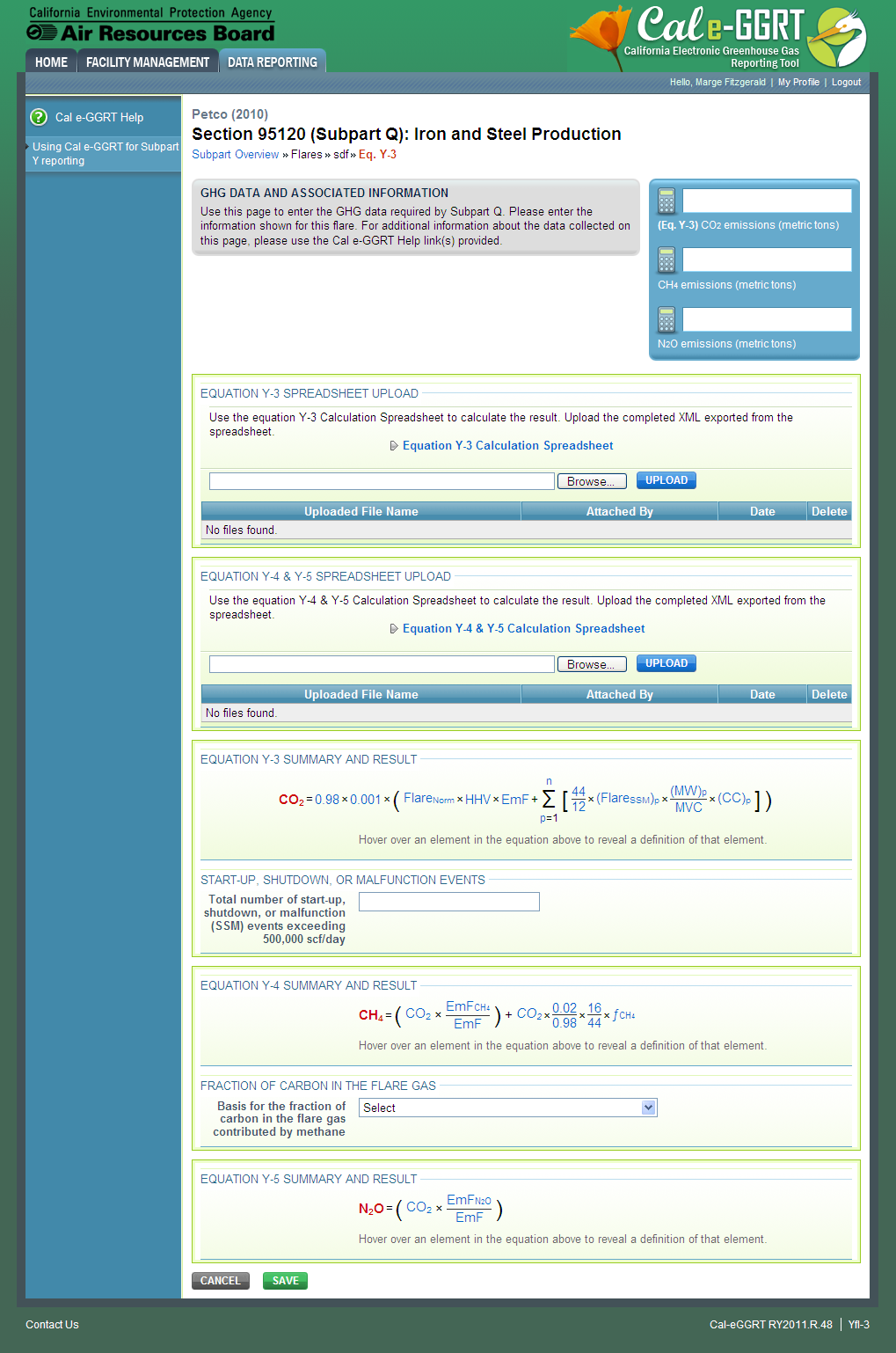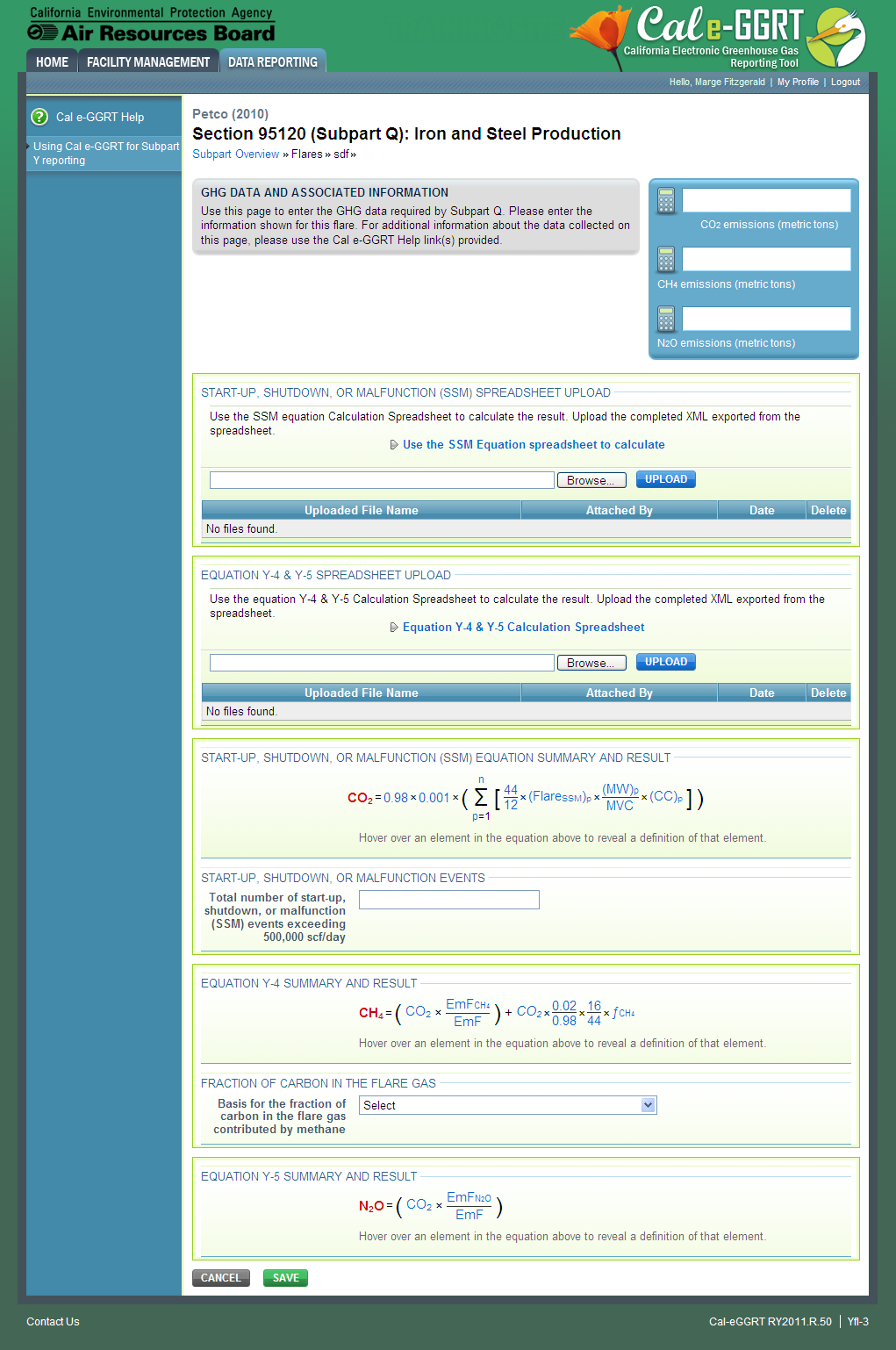This page provides a step-by-step description of how to enter Subpart Q Flares unit emissions information.
Step 1: Select a flare
To add or update flare emissions information, locate the FLARES table on the Subpart Q Overview page, and click OPEN.
Click image to expand
Step 2: Equation Summary and Results
The Equation Summary is presented on this page. You can hover over an element in the equation to reveal a definition of that element.
For each flare at your facility, Subpart Q requires you to enter the following emissions information:
- The annual CO2 emissions from flare unit operations (the output of Equation Y-1a, Y-1b, Y-2, or Y-3 depending on the calculation method used for this flare, in metric tons) [98.256(e)(4)]
- The annual CH4 emissions from flare unit operations (the output of Equation Y-4, in metric tons) [98.256(e)(4)]
- The basis for the fraction of carbon in the flare gas contributed by methane value:
- Method 18 at 40 CFR part 60, appendix A-6
- ASTM D1945-03
- ASTM D1946-90-Reapproved 2006
- GPA 2261-00
- UOP539-97
- ASTM D2503-92-Reapproved 2007
- Chromatographic analysis: manufacturer's instructions
- Engineering calculations
- Other (specify)
- The annual N2O emissions from flare unit operations (the output of Equation Y-5, in metric tons) [98.256(e)(4)]
To calculate annual CO2 emissions, download the calculation spreadsheet by clicking the link titled "Use Y-x spreadsheet to calculate" (where 'x' represents 1a, 1b, 2, or 3 depending on the CO2 calculation method used for this flare). Fill in the spreadsheet using the instructions in the spreadsheet. After completing the spreadsheet, copy the value of CO2 calculated by the spreadsheet to this page in the red box next to "Annual CO2 emission from this flare (metric tons)." Upload the completed spreadsheet using the space provided under the heading EQUATION Y-4 & Y-5 SPREADSHEET UPLOAD
Per §98.172(b), you must report CO2 emissions from flares that burn blast furnace gas or coke oven gas according to the procedures in §98.253(b)(1) of subpart Y (Petroleum Refineries). When using the alternatives set forth in §98.253(b)(1)(ii)(B) and §98.253(b)(1)(iii)(C), you must use the default CO2 emission factors for coke oven gas (46.85 kg CO2/MMBtu) and blast furnace gas (274.32 kg CO2/MMBtu) from Table C–1 to subpart C in Equations Y–2 and Y–3 of subpart Y.
To calculate annual CH4 and N2O emissions, download the calculation spreadsheets by clicking the link "Equation Y-4 & Y-5 Calculation Spreadsheet" Fill in the spreadsheets using the instructions in each spreadsheet. After completing the spreadsheets, export to XML using the instructions included in the spreadsheet, and upload to Cal e-GRRT using the BROWSE and UPLOAD buttons provided.
Per §98.172(b), you must report CH4 and N2O emissions from flares under subpart Q according to the requirements in §98.33(c)(2) using the emission factors for coke oven gas and blast furnace gas in Table C–2 to subpart C.
Step 3: Enter supplemental emissions information
For each flare using the Equation Y-1a calculation method, Subpart Q requires you to enter the following supplemental emissions information:
- An indication of whether daily or weekly measurement periods are used [98.256(e)(6)]
- The annual volume of flare gas combusted (in scf) [98.256(e)(6)]
- The specific consensus-based standard method number or description of the procedure specified by the flow meter manufacturer [98.256(q)]
- The number of days during the reporting year missing data procedures were used to determine the volume of flare gas combusted
- The annual average molecular weight (in kg/kg-mole) [98.256(e)(6)]
- The method used to measure molecular weight [98.256(q)]
- Method 18 at 50 CFR part 60, appendix A-6
- ASTM D1945-03
- ASTM D1946-90 (Reapproved 2006)
- GPA 2261-00
- UOP539-97
- ASTM D2503-92 (Reapproved 2007)
- Chromatographic analysis: manufacturer's instructions
- The number of days during the reporting year missing data procedures were used to determine molecular weight
- The annual average carbon content of the flare gas (kg carbon/kg flare gas) [98.256(e)(6)]
- The method used to measure carbon content [98.256(q)]
- Method 18 at 50 CFR part 60, appendix A-6
- ASTM D1945-03
- ASTM D1946-90 (Reapproved 2006)
- GPA 2261-00
- UOP539-97
- ASTM D2503-92 (Reapproved 2007)
- Chromatographic analysis: manufacturer's instructions
- The number of days during the reporting year missing data procedures were used to determine carbon content
Click image to expand
For each flare using the Equation Y-1b calculation method, Subpart Q requires you to enter the following supplemental emissions information:
- An indication of whether daily or weekly measurement periods are used [98.256(e)(7)]
- The annual volume of flare gas combusted (in scf) [98.256(e)(7)]
- The specific consensus-based standard method number or description of the procedure specified by the flow meter manufacturer [98.256(q)]
- The number of days during the reporting year missing data procedures were used to determine the volume of flare gas combusted
- The annual average CO2 concentration in the flare gas stream (in percent by volume or mole) [98.256(e)(7)]
- The method used to measure CO2 concentration [98.256(q)]
- Method 18 at 50 CFR part 60, appendix A-6
- ASTM D1945-03
- ASTM D1946-90 (Reapproved 2006)
- GPA 2261-00
- UOP539-97
- ASTM D2503-92 (Reapproved 2007)
- Chromatographic analysis: manufacturer's instructions
- The number of days during the reporting year missing data procedures were used to determine CO2 concentration
- For each carbon containing compound other than CO2 in the flare gas stream identified by the facility, and for each flare using the Equation Y-1b, the system shall require the facility to identify:
- The annual average concentration of the compound (in percent by volume or mole) [98.256(e)(7)(i)]
- The method used to measure concentration of the compound [98.256(q)]
- Method 18 at 50 CFR part 60, appendix A-6
- ASTM D1945-03
- ASTM D1946-90 (Reapproved 2006)
- GPA 2261-00
- UOP539-97
- ASTM D2503-92 (Reapproved 2007)
- Chromatographic analysis: manufacturer's instructions
- The number of days during the reporting year missing data procedures were used to determine the concentration of the compound
Click image to expand
To add a non-CO2 carbon-contain compound for the flare, click the "ADD a Compound" link in the CARBON CONTAINING COMPOUNDS (OTHER THAN CO2) IN THE FLARE GAS STREAM section on the Equation Summary and Result page and enter the required information.
When finished entering the required compound information, click SAVE.
Click image to expand
For each flare using the Equation Y-2 calculation method, Subpart Q requires you to enter the following supplemental emissions information:
- An indication of whether daily or weekly measurement periods are used [98.256(e)(8)]
- The annual volume of flare gas combusted (in MMscf) [98.256(e)(8)]
- The specific consensus-based standard method number or description of the procedure specified by the flow meter manufacturer [98.256(q)]
- The number of days during the reporting year missing data procedures were used to determine the volume of flare gas combusted
- The annual average higher heating value of the flare gas (Btu/scf) [98.256(e)(8)]
- The method used to measure higher heating value of the flare gas [98.256(q)]
- ASTM D4809-06
- ASTM D240-02 (Reapproved 2007)
- ASTM D1826-94 (Reapproved 2003)
- ASTM D3588-98 (Reapproved 2003)
- ASTM D4891-89 (Reapproved 2006)
- Chromatographic analysis: manufacturer's instructions
- The number of days during the reporting year missing data procedures were used to determine the higher heating value of the flare gas
- An indication of whether the annual volume of flare gas combusted was determined using standard conditions of 68 ºF and 14.7 psia or 60 ºF and 14.7 psia [98.256(e)(8)]
- An indication of whether the annual average higher heating value of the flare gas was determined using standard conditions of 68 ºF and 14.7 psia or 60 ºF and 14.7 psia [98.256(e)(8)]
Click image to expand
For each flare using the Equation Y-3 calculation method, Subpart Q requires you to enter the following supplemental emissions information:
- The total number of start-up, shutdown, or malfunction (SSM) events exceeding 500,000 scf/day [98.256(e)(9)]
- Basis for the fraction of carbon in the flare gas contributed by methane
Click image to expand
For each flare using the ARB 95113(d) - Start-up, Shutdown, Malfunction Equation calculation method, Subpart Q requires you to enter the following supplemental emissions information:
- The total number of start-up, shutdown, or malfunction (SSM) events exceeding 500,000 scf/day [98.256(e)(9)]
- Basis for the fraction of carbon in the flare gas contributed by methane
Click image to expand
Step 4: Save Your Data
When you have finished entering emission results, click SAVE.
After you save the data on this page, the next time you open the page, the calculator on the top of the page will display the CO2, CH4, and N2O emissions, rounded to the nearest metric ton. The value displayed is for informational purposes only.
Step 5. Repeat Steps 1-4
Repeat Steps 1-4 until you have entered emissions information for all flares at your facility.
See Also
Screen Errors
Using Cal e-GGRT to Prepare Your Subpart Q Report
Subpart Q Process Unit Information for Units NOT Monitored by CEMS
Subpart Q Process Unit Information for Units Monitored by CEMS
Subpart Q Coke Pushing Operations Information
Subpart Q Flares Information
Subpart Q Emissions Information for Units NOT Monitored by CEMS
Subpart Q Emissions Information for Units Monitored by CEMS
Subpart Q Emissions Information for Coke Pushing Operations
Subpart Q Emissions Information for Flares
Subpart Validation Report


